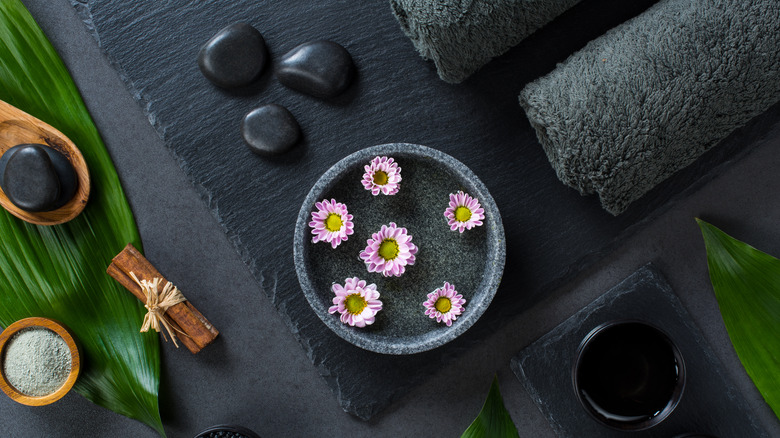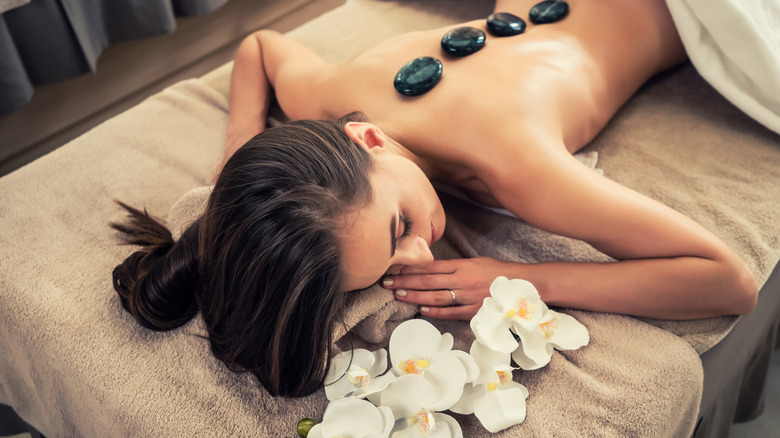
Ready to indulge in a hot stone massage? Make sure you know what to expect before trying things out. A hot massage can be a wonderful experience, but it’s not for everyone. This form of therapy uses smooth, heated stones to relax the muscles and relieve soreness. A small study published in the Journal of Research in Medical Sciences suggests that it may also improve sleep. However, more research is needed to confirm its potential benefits.
Massage therapy is clinically proven to relieve pain, decrease anxiety, and boost mental health. Clinical research suggests that it may benefit women with prenatal depression, as well as individuals with fibromyalgia, dementia, immune disorders, or skin conditions. In clinical trials, it reduced foot, knee, hand, neck, and back pain (via Complementary Therapies in Clinical Practice).
Hot stone massage has been used for over 5,000 years, notes Well+Good. Anecdotal evidence indicates that it can improve joint flexibility, decrease pain, and promote relaxation. “In a spiritual sense, hot stones are believed to have a quality within them that represents the core of the earth that omits a sense of grounding,” massage therapist Wayne Blankenship told the outlet. He also says that hot stone massages may relieve stress and anxiety. But even so, this centuries-old therapy may or may not be right for you.
Hot massage stones are heated to around 130 to 145 degrees Fahrenheit

A hot stone massage is an experience like no other. Most therapists use anywhere between 48 and 56 basalt rocks heated to around 130 to 145 degrees Fahrenheit, explains Everyday Health. Heat dilates the blood vessels and improves circulation, helping your body flush out toxins. “Combining heat with massage increases lymph movement and blood flow temporarily, improving skin appearance in areas that are more stagnant,” says dermatologist Ava Shambam (via Byrdie).
The therapist will place a towel or sheet on your body and then align the heated stones with your spine. The stones can also be placed onto your hands, feet, stomach, or forehead. Their role is to relax your muscles and prepare your body for the actual massage (via Healthline). Next, your therapist will gently stroke your body with the stones, glide them on your skin, or use Swedish massage techniques, depending on what you’re trying to achieve. Some therapists may also incorporate gemstones, cold stones, or massage oils.
A typical session lasts 60 to 90 minutes. Generally, it’s recommended to drink plenty of water before and after the massage to stay hydrated, notes Verywell Health. If possible, try not to eat anything for a few hours prior to your appointment. Let the therapist know about your health goals and how you feel during the massage.
Hot stone massage is not for everyone

This form of therapy appears to be more effective at relaxing the body rather than reducing pain, states the Minnesota School of Cosmetology. However, it carries potential risks that you may not be aware of. For example, if there isn’t enough material between the stones and your skin, you could end up with burns. That’s why it’s important to make sure you’re working with an experienced massage therapist.
Hot stone massages may not be safe for those with rosacea, melasma, and other inflammatory conditions, says dermatologist Jennifer Herrmann (via Byrdie). Exposure to heat can worsen these conditions, she adds. Likewise, this therapeutic method isn’t recommended during pregnancy. If you have heart disease, blood clots, or other conditions, get your doctor’s approval first (via Healthline). Also, note that massage therapy is off-limits for those with open wounds or burns.
Stay on the safe side and choose a reputable spa. Ideally, hire a therapist trained in hot stone massage. Let him know if you have an underlying condition, such as diabetes or varicose veins. Most importantly, try to relax and enjoy this experience to the fullest. Think of it as “me” time. If you’re stressed, focus on the physical sensations. Take deep breaths, relax your muscles, and observe how your body feels.
Source: Read Full Article